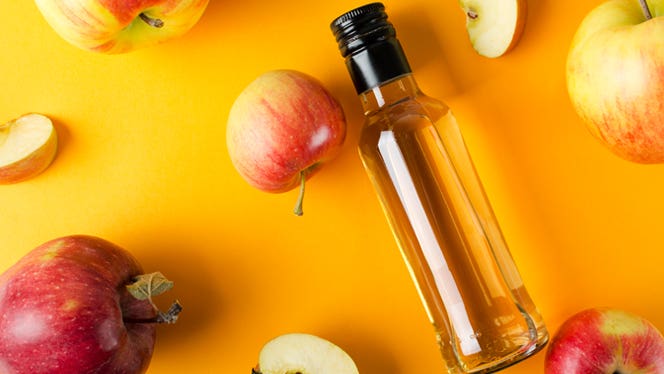
Why You Should Be Adding Apple Cider Vinegar to (Almost) Everything
What’s not to love about apple cider vinegar? The inexpensive, all-natural, fermented liquid is the unsung hero of so many recipes—even baked goods can benefit from a splash. Read on to learn more about baking with apple cider vinegar, as well as all the other ways you can put the potent ingredient to use in your kitchen.
Apple Cider Vinegar, Explained
Just one ingredient goes into apple cider vinegar: apple juice (aka cider), which is subjected to a two-step natural fermentation process. First, it is allowed to ferment until yeast and bacteria convert its sugars to ethanol alcohol. Then, a second fermentation takes place where acetic acid bacteria (AAB) use oxygen to turn the alcohol into acetic acid, or vinegar.
As the bacteria do their thing, they form a gelatinous cellulose film, called the mother, that floats on top and is removed or strained out before bottling. Store-bought apple cider vinegars have a standard acidity level of 5%, which prevents spoilage without tasting too sour.
Filtered vs. Unfiltered
In the kitchen, the choice between filtered and unfiltered apple cider vinegar is ultimately a matter of taste.
Filtered Apple Cider Vinegar
Filtered apple cider vinegar is also often pasteurized to extend its shelf life, preserve its taste, and prevent deposits from forming. It is pale and clear with a mildly fruity flavor.
Unfiltered Apple Cider Vinegar
Unfiltered apple cider vinegar is cloudy and darker with a more pronounced apple flavor. Raw, unfiltered apple cider vinegar continues to ferment and can develop deposits at the bottom or even a thin mother of vinegar film on top. They may look unappetizing but are perfectly safe to eat. They just mean the vinegar is continuing to ferment. Simply strain them out, discard, and use the vinegar as desired.
How to Use It as a Flavor Enhancer
It’s no real surprise to most cooks that apple cider vinegar can be used to punch up sauces, salad dressings, vinaigrettes, marinades, and pickle brines. Here are some other ways its distinctive tang can punch up your favorite recipes.
Soups and Stews
Stir 1 teaspoon to 1 tablespoon apple cider vinegar into soup just before serving to brighten the flavors, as in our Curried Sweet Potato Soup or your favorite vegan chili.
Roasted Vegetables
Sprinkle vegetables with apple cider vinegar before roasting to help seasonings stick and promote browning, as in our Roasted Veggie Bowls with Garlic Mashed Potatoes
Vegan Cheese
Add 1 tablespoon to lend a tangy, fermented element to nondairy cheese sauces, as in our fan-favorite Vegan Queso
Apple Cider Vinegar for Baking
Apple cider vinegar’s natural, neutral-flavored acidity is a major boon in baked goods and desserts. It can be used to curdle plant milk for buttermilk, added to doughs and batters to give them a tender crumb, and beat into mixtures need to be light and airy.
2-Ingredient Vegan Buttermilk
Mix 1 cup plant milk with 1 tablespoon apple cider vinegar, and let stand until it curdles. The vinegar adds a hint of sweet fermentation along with the acidity needed to mimic buttermilk.
Try it in: Irish Porridge Bread
Cookies, Cakes, and Pancakes
Add 1 teaspoon apple cider vinegar to cookie doughs and cake and pancake batters to reinforce the leavening power of baking soda and baking powder, as in our Vegan Strawberry Cupcakes.
Pie Crust
Add 1 teaspoon apple cider vinegar to pie dough to tenderize the crust, as in our Vegan Galette with Caramelized Onion and Vegetables.
Aquafaba Whipped Cream
Add ¼ to ½ teaspoon when whipping aquafaba (the liquid from canned chickpeas) into whipped cream. The vinegar will help stabilize its light, fluffy peaks. Try adding ¼ teaspoon apple cider vinegar to our Aquafaba Whipped Cream recipe.
Apple Cider Vinegar Health Claims
There’s a lot of hype about the purported health benefits of unfiltered apple cider vinegar. Although apple cider vinegar is a fermented food, it does not contain enough live beneficial gut bacteria to be considered a probiotic. And while some studies have linked ACV consumption with lower cholesterol levels and improved blood glucose in people with Type 2 diabetes, the evidence is relatively thin, as the American Heart Association noted in a 2024 article. What apple cider vinegar can do, however, is boost flavors enough to reduce the need for excess salt or fat in a recipe—a good thing for heart health.
To learn delicious vegan recipes and master whole-food, plant-based culinary techniques at home, check out Forks Over Knives Cooking Courses!
About the Author

About the Author
Mary Margaret Chappell
Join our mailing list
Get free recipes and the latest info on living a happy, healthy plant-based lifestyle.
By providing your email address, you consent to receive newsletter emails from Forks Over Knives. We value your privacy and will keep your email address safe. You may unsubscribe from our emails at any time.
